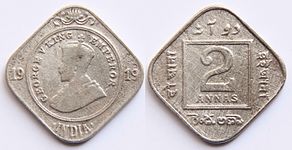| This article needs additional citations for verification. Please help improve this article by adding citations to reliable sources. Unsourced material may be challenged and removed. Find sources: "Indian anna" – news · newspapers · books · scholar · JSTOR (March 2024) (Learn how and when to remove this message) |
| 1 Indian anna | |
|---|---|

| |
| Obverse: Crowned bust of George VI, with lettering George VI King Emperor. | Reverse: Year of minting and face value in numeral, English, Urdu, Bengali, Telugu and Devanagari scripts. |
| 125,548,000 coins minted (1918 to 1940) in copper-nickel | |
| One Quarter anna. | |
|---|---|

| |
| Obverse: King George V crowned head surrounded by lettering "GEORGE V KING EMPEROR" at the periphery. | Reverse: Denomination and year surrounded by wreath. Lettering "ONE QUARTER ANNA INDIA 1933". |
| 1,681,276,200 coins minted from 1912 to 1936. | |
An anna (or ānna) was a currency unit formerly used in British India, equal to 1⁄16 of a rupee. It was subdivided into four pices or twelve pies (thus there were 192 pies in a rupee). When the rupee was decimalised and subdivided into 100 (new) paise, one anna was therefore equivalent to 6.25 paise. The anna was demonetised as a currency unit when India decimalised its currency in 1957, followed by Pakistan in 1961. It was replaced by the 5-paise coin, which was itself discontinued in 1994 and demonetised in 2011. The term anna is frequently used to express a fraction of 1⁄16.
Anna is derived from the Sanskrit अन्न, meaning "food".
There was a coin of one anna, and also half-anna coins of copper and two-anna pieces of silver. With the rupee having been valued to 1s 6d and weighing 180 grains as a 916.66 fine silver coin, the anna was equivalent to 9/8 d (one penny and half a farthing). Hence the 2 anna silver coins were of low weight (22.5 grains = 1.46 g).
Anna-denominated postage stamps were issued during the British Raj by the government of British India as well as by several princely states, and after independence until decimalisation of the currency by India and Pakistan.
Notation
The first number is the number of rupees, the second is the number of annas (1/16), the third is the number of paisas (1/64), and the fourth is the number of pies (1/192). Examples are given below.
- Rs 1-15-3-2 = Rs 1.9947
- Rs 1-8-3 = Rs 1.546
- Rs 1-4 = Rs 1.25
Coins
-
 One Twelfth Anna (1/12 Anna) coin of 1903
One Twelfth Anna (1/12 Anna) coin of 1903
-
 Obverse of the 1906 quarter anna, with the bust of Edward VII
Obverse of the 1906 quarter anna, with the bust of Edward VII
-
 2 Indian annas (1919).
2 Indian annas (1919).
-
 Annas - Paisa Conversion Table.
Annas - Paisa Conversion Table.
-
An 1835 quarter anna.
Stamps
-
 Half anna stamp of British India
Half anna stamp of British India
-
One anna stamp of Alwar
-
 Two anna stamp of independent India
Two anna stamp of independent India
-
 One anna and one and a half anna stamps of independent Pakistan
One anna and one and a half anna stamps of independent Pakistan
See also
References
- "Republic India Coinage". Archived from the original on 24 March 2015. Retrieved 14 July 2011.Accessed 14 July 2011.
- "British India Coinage - Coins of Queen Victoria". Reserve Bank of India.
- Schedule of Par Values, Currencies of Metropolitan Areas, The Statesman's Year Book 1947, pg xxiii, Macmillan & Co
- "British India Coinage". Reserve Bank of India.
| Indian rupee (₹) | |||||
|---|---|---|---|---|---|
| Subunits | |||||
| Coins |
| ||||
| Banknotes |
| ||||
| Symbol | |||||
| Mints | |||||
| Printers | |||||
| Topics | |||||
| Historic currencies of India | |
|---|---|
| Overview | |
| Ancient and medieval | |
| Near modern | |
| Modern | |
| Denomination | |
| See also: Economy of India Economy of Pakistan | |
| Currencies named rupee or similar | |
|---|---|
| Circulating | |
| Defunct |
|
| Conceptual | |
| Fictional | |
| See also | |